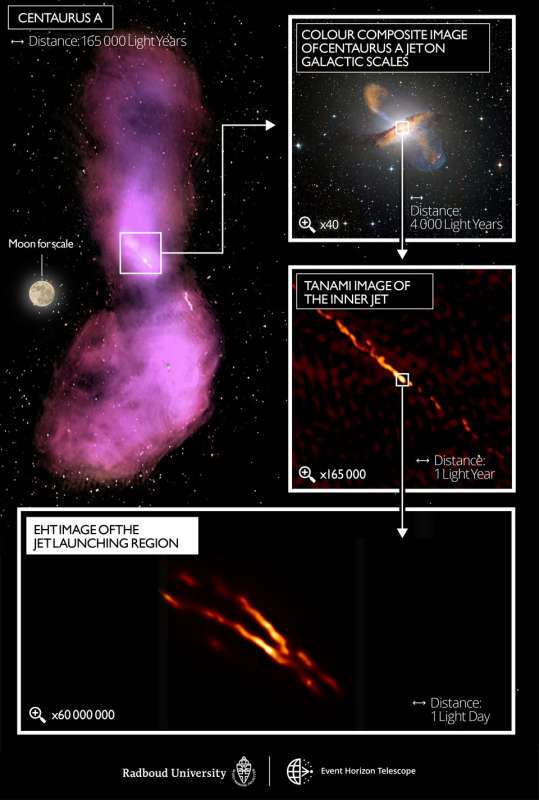
|
Credit & Copyright: Radboud University; CSIRO/ATNF/I.Feain et al., R.Morganti et al., N.Junkes et al.;
ESO/WFI; MPIfR/ESO/APEX/A. Weiss et al.; NASA/CXC/CfA/R. Kraft et al.; TANAMI/C.
Mueller et al.; EHT/M. Janssen et al.
Explanation:
How do supermassive black holes create powerful jets?
To help find out, the
Event Horizon Telescope (EHT)
imaged the center of the nearby
active galaxy
Centaurus A.
The cascade of
featured
inset images shows Cen A from it largest,
taking up more sky than many moons,
to its now finest, taking up only as much sky as an
golf ball on the moon.
The new image shows what may look like two jets -- but is actually two sides of a
single jet.
This newly discovered jet-edge brightening does not solve the
jet-creation mystery, but does
imply that the particle outflow is confined by a strong pressure -- possibly involving
a
magnetic field.
The EHT is a coordination of radio telescopes from around
the Earth -- from the
Caltech Submillimeter Observatory in
Hawaii USA, to
ALMA in
Chile, to
NOEMA in
France, and
more.
The EHT will continue to observe massive, nearby
black
holes and their energetic surroundings.
|
January February March April May June July August September October November December |
| |||||||||||||||||||||||||||||||||||||||||||||||||||||||
NASA Web Site Statements, Warnings, and Disclaimers
NASA Official: Jay Norris. Specific rights apply.
A service of: LHEA at NASA / GSFC
& Michigan Tech. U.
Based on Astronomy Picture
Of the Day
Publications with keywords: black hole - Centaurus A
Publications with words: black hole - Centaurus A
See also:
- APOD: 2025 December 3 Á Visualization: Near a Black Hole and Disk
- APOD: 2025 September 24 Á GW250114: Rotating Black Holes Collide
- APOD: 2025 May 9 Á IXPE Explores a Black Hole Jet
- APOD: 2025 May 6 Á The Doubly Warped World of Binary Black Holes
- APOD: 2025 May 4 Á Spin up of a Supermassive Black Hole
- APOD: 2024 December 11 Á The Shells and Jets of Galaxy Centaurus A
- APOD: 2024 November 24 Á Journey to the Center of the Galaxy
